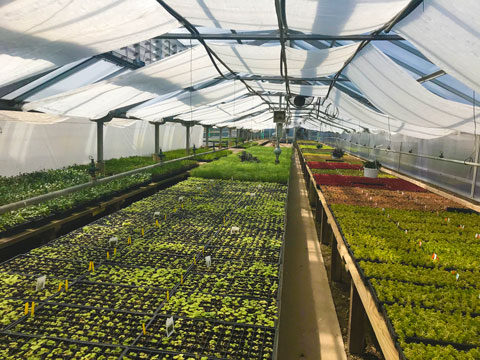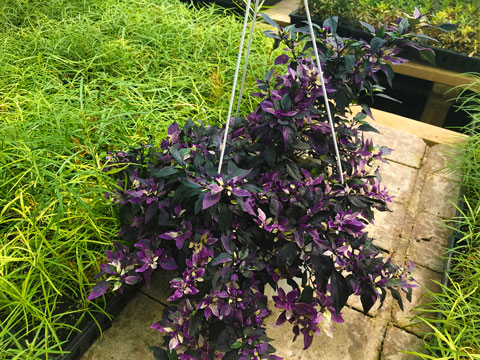7/1/2022
New Insect Pressure for 2022 & Beyond
Stanton Gill

We’ve been flooded with problems in horticulture during 2021 with Japanese maple scale, Emerald Ash borer, exotic Ambrosia beetles and Asian longhorned beetles. Now we have another to add to the list in Maryland, New York, Ohio, Virginia and Delaware: the spotted lanternfly (SLF, Lycorma delicatula). This name is great—it sounds like a cool fly with some sort of lantern. Actually, it’s a type of planthopper from Asia found in our trading partners’ homelands of China, Korea, India and Vietnam.
Pictured: A greenhouse practicing biocontrol techniques.
It was found in Pennsylvania and confirmed in Berk County on September 22, 2014. On November 1, 2014, Pennsylvania put on a quarantine to try to restrict the movement of this pest. In 2021, landscapers and garden centers in Maryland purchasing plants from quarantine areas in Pennsylvania managed to haul adult SLF to many of the counties in Maryland. The Maryland Department of Agriculture is still assessing where these adults have laid egg masses and weighing whether to expand the quarantine area in Maryland. Hopefully in 2022, you don’t get a chance to experience this new pest. Close vigilance in avoiding bringing this pest into your area is one positive step you can take.
Greenhouse growers are seeing that SLF can feed on many species of plants, but we haven’t detected any real damage on most herbaceous greenhouse crops. Still, if your area becomes a quarantine part of your state, there are many regulations placed on shipping of plant material leaving the quarantine area. This will mean additional vigilance and more paperwork if your area is placed in quarantine. Fortunately, we have several materials that can be applied to SLF for effective control.
Meanwhile, outdoors in August and September of 2021, on the east coast and Midwest, lawn companies noticed their customers’ lawns were bare of turfgrass. The fall armyworm (Spodoptera frugiperda),which is a southern species, was carried north as adult moths to many states on the east coast and Midwest. The fall armyworm has been labeled a large-scale invasive and is called “armyworm” because in its larval stage individuals gather in huge masses, like human armies, which can destroy large tracks of crops. It’s native to South and North America, and is an invasive that America has now shipped to Africa.
The moths laid eggs in turfgrass and the larvae consumed huge amounts of leaf area in lawns, turning them brown in four to five days. There was a grass seed shortage and prices of grass seed increased two to three times normal prices. This made it tough for companies to try to green up their customers’ brown lawns this fall. It was unusual weather patterns with strong southerly jet streams in 2021 that carried this species out of the south into the Midwest and east coast. Since this caterpillar is semi-tropical, it shouldn’t overwinter in most areas that it invaded in 2021.
Switching back to greenhouses and invasive pests
The good news for growers is that thrips populations were down in most greenhouses in the summer of 2021 in Maryland, Virginia, Pennsylvania and
several other east coast states. The frequent rains of summer, encouraging entomopathogenic fungi, kept thrips populations outdoors down, so there were fewer to migrate into greenhouse operations. The relatively wet summer did encourage European pepper moths to thrive this summer.
As we move through the early part of 2022, greenhouse growers are moving rooted cuttings and plugs into the greenhouse, shipped in from Central America and Africa. Many of these locations have continual pressure from thrips populations despite close monitoring by horticulture companies. Unfortunately, bringing these plants from high-insect incidence parts of the world often mean thrips are often present in egg form or low populations and go unnoticed. We’re seeing an increasing number of these thrips arrive that show extremely strong resistance to many classes of pesticides.
What should you do?
The best course of action for greenhouse growers is to use a 50- to 100-gallon water container to mix up SuffOil-X with the entomopathogenic fungus Beauveria bassiana. SuffOil-X is one of the only horticultural oils on the market labeled for using as a plant dip. This product may be used to control mite and insect pests in the egg stage, including spider mites, eriophyid mites, armored scale, soft scale, mealybugs, psyllids, whiteflies, aphids, leafrollers and leafhoppers.
 Pictured: Ornamental Pepper Purple Flash can be used as a banker plant for predacious mites like Amblyseius cucumeris.
Pictured: Ornamental Pepper Purple Flash can be used as a banker plant for predacious mites like Amblyseius cucumeris.
Take the plug trays that arrive at your greenhouse and immerse them in the SuffOil–X and Beauveria bassiana mix. The entomopathogenic fungi in the mix allows conidia to be covered on the insects’ bodies, adding to the efficacy of the oil.
This preventative treatment has been used both in the United States and Canada by several growers with good results. It’s a good, proactive way of suppressing pests that can potentially be brought into your greenhouse early in the season.
Follow up with distributing the predacious mite Amblyseius cucumeris. Fortunately, there are several national companies that can supply these predacious mites. BioBee has a brand name, BioCucumeris; other suppliers include IPM Labs, Biobest and Arbico, just to name a few of the many sources available online.
A. cucumeris can be applied for the biocontrol of different thrips species, including Frankliniella occidentalis, Thrips tabaci and others in vegetable and ornamental plugs and transplants. This tiny predator with a pale color and a pear-shaped body develops within the crop without the prey if a pollen source is available. A good pollen source is marigolds or ornamental pepper plants such as Purple Flash or Red Missiles. Place the pollen source plants among your growing area. Be sure to start these banker plant ornamental peppers in January so they’re producing flowers by March. This will help get you started onto your early insect control in the greenhouse for 2023. GT
Stanton Gill is an Extension Specialist in Entomology and IPM for Greenhouses & Nursery for the Central Maryland Research & Education Center, and Professor in the Landscape Technology Program for Montgomery College. He can be reached at Sgill@umd.edu or (410) 868-9400.